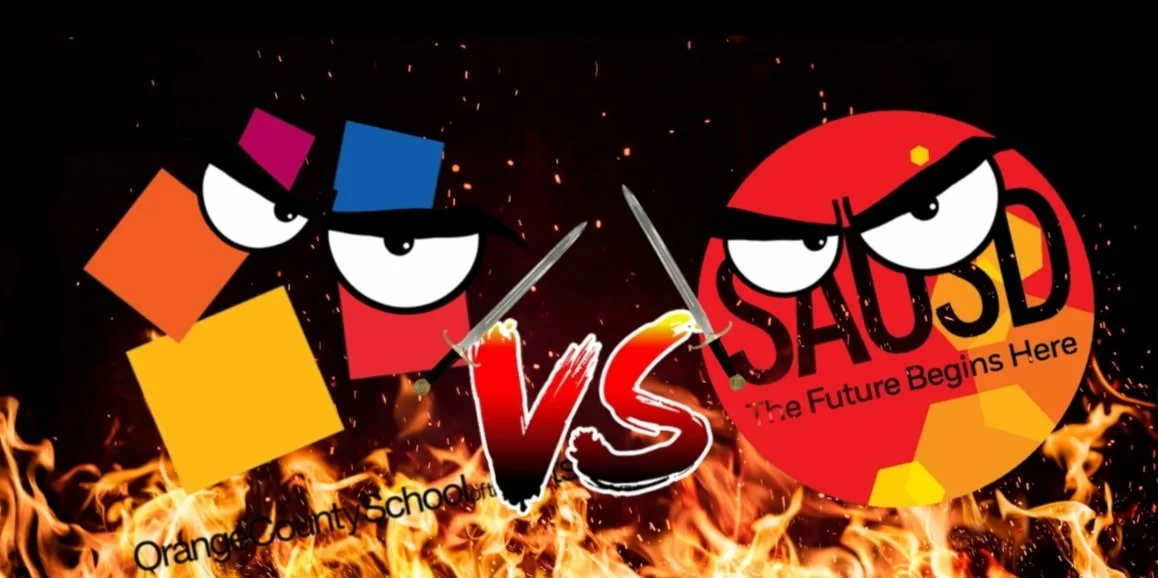Noise, Dust, Traffic: Update on OCSA Construction
Joey Zhou & Rosie Greenwood
Any OCSA student — new or returning — had one common thought on the first day of school: “What is up with all the construction?” With the current, disheveled state of the blacktop, blocking paths to the Tower and Annex, it’s pretty hard to miss.
In 2022, OCSA announced a concept called “Students First: A Capital Campaign.” Attached to this announcement were many digitally rendered concept images of the intended new campus. A few of the features in the images include a student lounge for studying and a fence surrounding the campus.
This past spring semester, the exterior stairs were completed and made available for student usage this fall semester. Additionally, a new mural for the annex was painted and uncovered. Additional improvements are expected to be finished by early spring of 2026, leaving seven more months of construction. Many acknowledge the importance of improving the OCSA campus, with students and teachers alike approving the campus’ ideas for the beautification upgrade. However, many said that there are numerous negative aspects getting in the way of student life as well.
Emma Gelinsky (MT ‘28) mentioned how the construction “adds traffic,” as well as an “unnecessary stress of getting to class.” The root of both of these problems seem to be the lack of walkways on the current campus. There's only one walkway, roughly hallway-sized to get from 10th Street to the Annex. During passing periods, an extreme blockage rises from the lack of space to travel between the buildings. Ada Wei (VA ‘28) added how “OCSA feels less welcoming and familiar than before.” The space has been reduced from a large, open area to a closed-off region barely wide enough to accommodate more than three students walking together. These inconveniences have made tardies a more common occurrence for students.
Furthermore, some students are proposing alternative solutions, such as the separation of the stairwells. Elena Abdollahi (IM-SO ‘28) explains how there is more stair traffic because “you can’t tell who is trying to get to the stairwell and who is trying to get into a classroom.” She suggests assigning classrooms to either stairwell similar to OCSA’s policy regarding emergency situations.
In addition to that, some unspoken traditions of OCSA culture have been disregarded due to the construction. Besides stair traffic issues, lunch areas have been heavily reduced as well, with many students cramming together in the DMS quad. Lyla Han (IM-SO ‘26) describes how “usually only seniors sit near the potted trees but the underclassmen are taking up all the space because the containers are gone.”
These modifications to the campus affect the student experience, especially for many seventh graders, who are experiencing their first year on an unfinished campus and seniors who are experiencing their last year of high school in a construction zone. The inconveniences of construction have made this school year feel pretty hectic and uncertain, but the creative image of a grand and magnificent campus remains, tying our community together with resilience. The challenges are real, but so is the excitement waiting to come! By the time construction is finished, the school will not only look improved, but provide new opportunities for comfort, growth, and collaboration. The OCSA community continues persevering the difficulties with persistence, knowing the end result will be worth the wait!
One State, Two State, Red State, Blue State
Audrey Smith
California’s Proposition 50 is controversial, to put it lightly. Some argue it goes against every democratic principle that this country was built upon, while others believe it’s a drastic — albeit necessary — solution to a dire problem. But what is Prop 50 really about?
Early into President Trump’s second term, he had the lowest 100-day approval rating in the past 80 years. With midterm elections looming, the Trump Administration has been preparing to try and secure another Republican win. Among efforts to ensure a red majority, Governor Greg Abbott is attempting to redraw Texan congressional districts in order to gain five Republican seats in the House of Representatives. This is referred to as gerrymandering, or redistricting congressional districts (regions with the ability to elect a member for the House) to have a majority of voters for one political party. This is achieved by clumping together smaller sections of heavy metropolitan — often democratic-leaning — areas with large swaths of rural land which tend to lean more Republican.
Many Democratic politicians across the country have admonished Abbott’s behavior, calling it an attack on democracy. Nevertheless, Abbott has disregarded many of these critiques. In response, California Governor Gavin Newsom is choosing a shift in strategy, deciding to fight fire with fire. Newsom has proposed the “Election Rigging Response Act”, or Prop 50 — a similar redistricting proposal. It is gerrymandering, but in favor of Democrats. If his proposal goes through, California will gain six Democratic seats in the House — effectively nullifying Texas’ redistricting. The main difference between the two is that Prop 50 will only go through with the support of California voters, whereas Texas can redistrict without input from Texan voters.
However, Texas and California aren’t the only states to hop onto the gerrymandering bandwagon. Indiana, Missouri and Florida have all voiced an interest in joining Texas, which if all successfully redistricted, would lead to an additional 17 Republican representatives. Similarly, Ohio, Maryland, and New York have all expressed an interest in redistricting, and if successful, could result in 27 additional seats for Democrats.
Currently, it is unclear which way these redistrictings will go. Even if used as a drastic measure, gerrymandering is a slippery slope, already spreading across the country like wildfire. Ideally, none of these states would be redistricting in the interest to boost a political party’s power. But there is little to be done to stop Texas from redistricting, and the subsequent retaliation from California and other states.
Various political scientists have voiced concerns, fearing that this gerrymandering war will only further cement the number of Republican and Democratic seats in the House. Fewer swing seats reduce representatives’ receptiveness, given the threat of losing an election compels them to listen to their voters. When representatives from a political majority feel secure, the incentive to act on behalf of their constituents — while also upholding the Legislative branch’s role in checks and balances — diminishes. If representatives feel they don’t need to listen to the district they represent due to a larger red or blue majority, then the legislative branch cedes power to the Judicial and Executive branches. At best, this war counteracts an overreach of political power, and at worst, leads to the disempowerment of the legislative branch. As citizens and eventual voters of California, it’s crucial to stay up to date on propositions that appear on our ballots — weighing the causes and effects on us as well as our broader communities.
Inflation, Subisdies, and Reform, Argentina's Presidential Transisiton
Candela Aspiazu
In the changing political landscape of the world, many new leaders have been emerging with policies to streamline tumultuous foreign affairs. Among these countries is Argentina, led by President Javier Milei since Nov. 19, 2023. His different approach to governance compared to his predecessor, Alberto Fernandez, has been a very controversial topic for the citizens of Argentina and, quite frankly, the rest of the world as well. Nevertheless, it is crucial to expose the unbiased truth about the changes occurring in Argentina and their effects on the lower class.
Compared to previous presidents, Milei has established much stricter policies centered around lowering inflation. Argentina has been experiencing extreme surges in prices for years, with it reaching a record high of 211.4 percent in 2023. Milei claims that in order for the economy to get back on track, the government must make "drastic cuts” in public expenses. These cuts primarily include funding reductions on various subsidies that have been essential resources for many. While these subsidies were helpful to many lower income citizens, they were also continuously abused by individuals who supposedly “qualified” for them just to exploit their financial benefits. These cutbacks have managed to bring inflation down the lowest it’s been in five years — putting it at a record 1.5 percent in May 2025.
Though Milei's strategy has proven effective, it has still been a shock for many other citizens. Under Milei’s administration, the prices of basic living skyrocketed; turning it into a nation where coffee goes for an average of 7905.49 Argentinian Pesos, or $5.81 US Dollars. This was extremely new for many middle class individuals used to the democratic government from previous president Alberto Fernández, who led under Kirchnerism. This social system played a big role in the difficulty of transitioning from one government to another. Under it, people of all classes receive large amounts of money from subsidies where they apply for different plans, and receive pay from the government depending on their situation. There are subsidies for nutrition, infants, scholarships, medicine and many more. This generous style of government has fueled the never-ending cycle of lower-class financial aid that grew the country's inflation.
Under new leadership, prices are the highest they have ever been. Subsidies are more limited, and offered exclusively to Argentinian citizens in much lower quantities. Milei’s tactics for managing inflation has aid-dependent Argentinians currently tight on money, but with a promise of a much brighter economic future.
Despite these drastic changes, Argentina seems to be moving on the road to recovery — from a democratic, giving government to a stricter and more expensive one. Both Alberto Fernandes and Javier Milei have their negatives and positives, but the ending product of their presidencies seem to be moving in opposite directions. The reality of the matter is that the situation is different for every person of every economic status. But which version of government leads to the best future for Argentina? With time, we’ll see.
Pulling the Plug on PBS
Asmi Aggarwal & Alyssa Kim
Wild Kratts, Arthur, Curious George, Sesame Street — sound familiar? Public Broadcasting Service (PBS) shows have shaped the way generations of students learned, laughed and grew. For many of us, they weren’t just TV shows: they were our earliest teachers and first exposure to the ABCs. However, the legacy of PBS is now at risk after federal funding cuts.
The origin of PBS dates back to the Public Broadcasting Act of 1967, which established the Corporation for Public Broadcasting (CPB) as one of its principal funders. As a federally subsidized nonprofit, the CPB distributed grants to public broadcasters such as PBS. PBS succeeded the National Educational Television network in 1970, consolidating disparate programming into a nationwide system. Since then, it has produced more than 120 original series and distributed hundreds more — providing free, high-quality educational content that advances children’s intellectual and social development.
That legacy, though, has come under political scrutiny in past years. In recent budget debates, President Trump approved $9 billion in foreign aid cuts including $1.1 billion aimed at defunding the CPB, PBS’s primary federal backer. However, such measures were not completely unprecedented. Throughout his first term, Trump repeatedly sought to reduce allocations to public broadcasting, claiming PBS and NPR reflect liberal biases and no longer warranted taxpayer support. Congress blocked these efforts, defending public broadcasting as an essential source of educational and cultural programming.
Trump’s second-term initiatives, nevertheless, proved more decisive. With the signing of an executive order titled “Ending Taxpayer Subsidization of Biased Media” and the passage of the Rescission Act of 2025, funding from PBS was formally withdrawn. Officials framed the cuts as a strategy to curb federal spending and shift educational authority to states and private groups. On Aug. 1, the CPB announced its planned shutdown by January — effectively dismantling the system that had sustained PBS for decades.
The erosion of PBS has simultaneously created space for alternative media to shape classroom instruction, marking a profound ideological shift in American education. Recently, conservative media nonprofit PragerU has been gaining traction in schools across the country. Founded in 2009, the organization produces short videos on history, civics and culture, several of which have been approved for use in some states. Although no policy has formally positioned PragerU as a substitute for PBS, the Trump administration has consistently promoted the platform at various educational forums.
Much of its content has provoked sustained controversy among educators and scholars. One video, for example, portrays Frederick Douglass as defending the founders’ decision not to abolish slavery in the Constitution, claiming it ensured the Southern colonies’ support for the Union. Yet, the video omits his broader condemnation of slavery and the exclusion of African Americans, particularly evident in his declaration, “Our system is wonderful, and the Constitution is a glorious liberty document.” Critics argue such omissions distort his message and exemplify PragerU’s broader pattern of presenting inordinately conservative viewpoints that oversimplify complex historical realities. Produced largely by media personalities and activists rather than historians, its videos undergo no independent academic review which has raised questions about their reliability and value in the classroom.
Ultimately, for many viewers who grew up watching PBS on cable, recent developments might seem like the closure of an important childhood chapter. Nevertheless, the legacy of PBS is not being completely erased. These beloved shows are now anticipated to stream on different outlets which, with the steady support of viewers, will continue to provide programming for stations across the globe.
Meet the New Dance Directors
Sloane Adams
The world of movement and artistry in dance is constantly evolving. Over time techniques change and develop encompassing the exploration of dancers of all ages in not only technique and style, but even fashion sense as well.
This fall semester, we welcome two new School of Dance Conservatory Directors who will take part in the growing culture of OCSA’s dance conservatories and students. Now running CMD is Lauren Lim Jackson (CMD ‘03) and the new head of BCD is Paige Amicon. Both of these authentic movers have an outstanding history of dance experience and are looking forward to further blossoming the depths of dance.
Jackson graduated OCSA in the CMD conservatory in 2003, encountering a true full-circle moment upon her return. Later, she studied at Harvard University where she did not major in dance, but was a part of different student groups involving dance. After receiving her degree, she moved to New York City and proceeded to tour the world with West Side Story. Jackson shared, “It’s such a gift to come back, help shape the next generation, and bring some of that institutional memory of commercial dance, but blend it with the direction it is going now.” Additionally, Jackson wants to concentrate on self care, mentally and physically. She finds that being a dancer is sustainable when you are able to acknowledge your worth is not based around how you perform in classes or on stage. Jackson is extremely centered on getting to know her CMD students and playing a role in their growth.
Amicon, who is now the head of BCD, attended college at North Carolina School of the Arts where she focused on studying contemporary dance. Following graduation, she relocated to Los Angeles where she freelanced for about nine years. One of the most impactful opportunities for her was participating in Ate9 Dance Company led by Danielle Agami. Amicon explained, “It was so rich, full, and busy. I think it mirrors being a director and all the hats you wear administratively with curriculum, curating shows, teaching students and working with the faculty.” She hopes her students continue to stay curious and ask questions. “I am most excited to dream with BCD,” said Amicon, who is interested in how to transfer all the hard work done in class and present it on stage in new ways.
Enthusiasm is in the air as we celebrate art through these two new directors. Both are eager to support all of their students, whether they plan to dance in their future or not. Jackson and Amicon both believe that dance is not only a form of expression, but it is a way to learn how to be human. The training, discipline, adaptation, and flexibility necessary to dance are skills that can be communicable in life outside of movement. There is so much knowledge to gain and be discovered from these beautiful artists; and the journey has just begun.
Done At Last: The End of OCSA vs. SAUSD
Ellie Choi
In 2019, SAUSD sent OCSA an unexpected invoice for nearly $20 million, claiming that OCSA owed its share of special education costs for the years 2002 to 2019. OCSA responded by filing a lawsuit against SAUSD on the basis that the invoice was unlawful. OCSA President & CEO Teren Shaffer told Evolution that SAUSD’s demands contradicted “what [OCSA] believed to be a legally binding charter contract agreement."
To secure its independence from SAUSD, OCSA took steps in 2020 to move its charter authority from SAUSD to Orange County Department of Education. With a loan from Farmers & Merchants Bank, OCSA will pay the settlement amount in installments over an extended period of time.
In early 2025, a Los Angeles judge ordered OCSA to pay $16 million of SAUSD’s claim. Faced with the possibility of financial distress, the OCSA community mobilized. In the spring of 2025, thousands of OSCA students, parents, teachers and other supporters called elected officials and showed up at SAUSD board meetings to protest and provide live testimony about the profound benefits of an OCSA education and the implications for thousands of students of losing this legal dispute.
Helena Donato-Sapp (CW ‘27) started a petition-signing campaign in support of OCSA. “The thing that motivates me to speak up and advocate for OCSA is that the issue at hand – special education services – is deeply personal to me because I have four non-apparent learning disabilities,” Donato-Sapp said. “I had to speak up for the rights of all disabled students because we deserve a fair and equal education.”
Rather than pursuing a costly appeal, OCSA’s Leadership Team and Board of Trustees sought mediation with SAUSD Board members. Over the summer, the parties were finally able to reach a resolution.
“When the dispute was finally resolved, I felt a tremendous sense of relief, a weight being lifted, and optimism for the future,” Shaffer said. “This outcome enables OCSA to rebuild a sense of stability and look toward a brighter future ahead.”
Just weeks before the start of the new school year, OCSA settled its lawsuit against the Santa Ana Unified School District (SAUSD), agreeing to pay $8.55 million, less than half of the approximately $20 million originally demanded by SAUSD back in 2019.
“Now that the lawsuit has been settled, what’s more important than the money lost is the community that came together, demonstrating how OCSA continues to inspire thousands of students annually,” Student Body President Ronit Shiroy (IM-J ‘26) said. “I was a little worried about the lawsuit and the implications it would have on OCSA’s future, yet seeing the strong support that showed out at all the OCSA v. SAUSD meetings gave me hope that it would all be okay.”
As OCSA looks ahead to its 40th anniversary next year, the school is preparing for a new five-year strategic plan. “With the SAUSD litigation behind us, we can now fully dedicate our energy and resources to what matters most – our students – and to creating the best possible environment for everyone who is part of the OCSA community,” Shaffer said.
Teacher Summer Recap
Victoria Seoah Baek
Summer 2025 was a time of café trips with friends, reading, watching newly released movies and preparing for the new school year. Over the summer, two of OCSA’s English teachers spent meaningful time with loved ones. For Courtney Harper, this summer was about finding joy in small moments. Ashley Jan spent her first summer with her toddler. As we return to the classroom, both teachers bring a refreshed energy, enhanced love for books and sincere advice for the new school year.
Courtney Harper enjoyed a peaceful and audiobook-filled summer. She has been at OCSA for a decade and teaches Lit & Comp 7, Modern Voices and Media Studies, and Yearbook. She previously taught in the live theatre industry before transitioning into a teaching career.
In previous summers, Harper has travelled to Africa and Europe, but this year was different: she found joy in cherishing simple things, such as a week-long trip with family to La Jolla. Harper spent her summer recharging: often listening to audiobooks, completing 1000 piece puzzles without looking at the picture and watching TV. Her life is rich yet simple, with easy-going pleasures, such as quality time with family, or fulfilling her love for Jurassic Park (of course, with her dog Winnie curled up beside her).
Two books that she recommends that have “a touch of magic” are “The House in the Cerulean Sea” by TJ Klune, and its sequel, “Somewhere Beyond the Sea.” Other recommended novels include “The Lost World” by Michael Crichton, “The Briar Club” by Kate Quinn, “Shakespeare Was a Woman and Other Heresies” by Elizabeth Winkler, and "By Any Other Name” by Jodi Picoult.
As the school year begins again, Harper advised students to remember: “You are exactly where you need to be right now. Don't worry about what anybody else is doing.”
Ashley Jan has been at OCSA for nine years and is starting her first year back after an off-year. Jan was inspired to teach by a strong legacy of English teachers who encouraged her to foster a love for reading and writing: “I grew to really enjoy helping people find their voices as writers and I felt like I could see myself doing that for a long time.”
This past summer was the first summer she spent as a mom. She enjoyed “getting to see summer through her [daughter’s] eyes.” Her summer was full of library story-times, park trips and watching her daughter splash around at a water table.
Similar to many teachers, Jan found herself reading a lot of texts related to her teaching curriculum, but after COVID, she started to read for enjoyment again. Her book list for Summer 2025 include East of Eden by John Steinbeck and the Emily Wilde series, which she described as “a textbook for fairies.”
Jan’s advice for the new school year is “don’t be afraid to ask your teachers for support. I don't see a student stopping by during Office Hours as a weakness, but I actually see it as a strength. Being able to ask for help when you need it makes for a successful student.”
Cautions for Content Creators
Kimura Carlsten
Everyone I know wants to be an influencer. Sure, it’s a fun job that comes with the perks of brand deals and fame, but what about the side of teen influencers that no one talks about? It’s surely not all fun and games
Ashley Barnes joined TikTok at the age of 14. Her account seemingly blew up overnight, amassing over 3.5 million followers. During her time on the internet, she’s always been honest about her mental health, and she’s talked openly about how her ongoing legal battles and depression have affected her. Her platform and videos have given her audience – even the most secluded – a home and a deeper connection to Barnes's life.
Barnes’ follower count kept growing until her downfall came this August. At one of the Los Angeles parties that she is famous for, many teens made claims on social media of Barnes pressuring her attendees to drink alcohol, consume THC gummies, and partake in sexual activities. To conclude this night, allegations formed that Barnes encouraged someone to cheat on his girlfriend of four months.
After these accusational videos were posted, Barnes stayed silent; her account was inactive. Rumors spiraled, and the internet took matters into its own hands. At first, the attacks on her were virtual, only losing millions of followers; however, as time went on, it took a turn for the worse. People started going out of their way to film Barnes whenever they saw her in public. Not only that, she was doxxed on multiple occasions. These inexcusable allegations have now caused major controversy because, while she might have been responsible for these actions, this shouldn’t hurt her in real life.
In an apology video posted by Barnes, she claims that after the incident, she was sent to rehab for substance abuse issues. She stated that social media had consumed her life. Once money got involved, it didn’t matter what she wanted to do. All that mattered to her and the people around her was the next video she needed to produce.
Exploitation is a big problem in the realm of influencers. Just like with Barnes, social media takes over these teens’ lives. One teen influencer, Piper Rockelle, grew up being a child star, and her entire life has been documented.
Now, Piper has moved her brand onto TikTok with more than 17 million followers. A popular TikTok account showcasing a group of adult content creators has recently been under fire for exploitative activities with Rockelle. Back in January, Rockelle and this content house collabed, even though Rockelle was only 17 years old. In some videos, she wore revealing clothing that contributed to the public’s opinion that this situation is a case of exploitation. It’s obviously not legal for a minor to post any explicit content, but they constantly threw hints about it. This pushes the limits of child safety on the internet. Often, when social media influence is incentivized with money, people forget there’s a human in front of the camera.
These are only a couple of many examples of the dangers social media can bring. Social media pushes into personal lives, making it almost impossible to remain sane. Still, do you want to be an influencer?
Symbolism of Superman
Sophie Sukendro
James Gunn’s “Superman,” released July 11, has become one of the year’s most controversial films. Branded “SuperWoke” by critics and the target of boycotts across political lines, the movie has reignited debates about immigration, cultural identity and foreign policy. While Gunn has repeatedly emphasized that the film is fictional, public backlash reflects broader tensions in society, particularly around immigration and world conflicts.
At the center of the debate is Superman’s identity as an immigrant. Gunn described the character as “the story of America,” noting Superman’s identity as an immigrant and that his narrative emphasizes “basic human kindness.” This framing connects to Superman’s origins in 1938, when Jerry Siegel and Joe Shuster created him as a figure of hope during rising fascism in Europe. Yet critics argue that highlighting Superman’s immigrant background subjects a classic American icon to the “liberal agenda.”
“We don’t go to the movie theater to be lectured to, and to have somebody throw their ideology onto us,” said Kellyanne Conway, President Donald Trump’s former senior adviser. Trump’s official social media posted an edited film poster featuring Trump’s face on Superman’s body captioned, “The Symbol of Hope. Truth. Justice. The American Way. #Superman Trump.” Some fans have gone further, threatening to boycott the franchise, citing Hollywood’s history of perceived liberalism.
The plot added another layer of controversy. Superman confronts Lex Luthor, a billionaire arms dealer backing Boravia, a powerful nation invading smaller Jarhanpur. Boravia is supported by the United States government, criticizing the U.S.’s complicity in foreign interventions. Some audiences instinctively drew comparisons to the Russia–Ukraine conflict and the Israel–Palestine conflict, though the latter was a more prominent theory.
However, Gunn denied that the film was meant as commentary on the Middle East, stating, “When I wrote this the Middle Eastern conflict wasn’t happening. It really is fictional." He explained that the intent was to portray a despotic nation invading a weaker one, not to allude to current global conflicts. Despite this, some viewers still find the parallels uncomfortably pointed.
Feeling indicted by fiction doesn’t prove the film’s bias so much as it reflects our own awareness of real-world inequalities. To take offense at the allegory and its theoretical parallels is to acknowledge, consciously or not, that the storyline resonates with reality. It exposes our own unconscious recognition of power dynamics and wrongdoing. Film, like any art form, has always been subjective. So when a story provokes anger or offense, it’s not the story speaking, it’s our conscience.
Superman has always been political, from his 1938 debut as a champion against fascism to his modern-day interpretations. The fact that he continues to provoke controversy nearly 90 years later demonstrates the enduring weight of his cultural symbolism. The broader takeaway is how fractured our cultural landscape has become. The film may not have been written as commentary, but the way audiences reacted is a commentary on society itself. Superhero movies have always revolved around power struggles: control-hungry villains, weaker forces who resist, and heroes who fight to restore balance. For decades, audiences accepted these plots as symbolic—a classic superhero plot. Today, those same plots are quickly linked to real world conflicts. This shift reflects both a heightened political consciousness and a level of polarization that makes even fiction a source of division.
To Skibidi or not to Skibidi?
Charlie Patmon
If I were to list every “brain rot” phrase or meme trending as of the last six months in this article, this publication would resemble a novel more than a newspaper. “Brain rot,” Oxford University Press’ 2024 Word or Phrase of the Year, is described as the consumption of low-quality, insignificant content, targeted particularly towards the youngest generation, resulting in a decline in critical-thinking skills, or the rotting of the brain.
“Brain rot” has become somewhat of a language, creating a buzz among the youth, leaving the adults stunned and confused. It is a rat-race of stimulant consumption, as all rush to learn and abuse the new phrases, sounds and words until we’re tired of them. To the average viewer, it may seem to resemble the linguistic tendencies of the youth that have occurred since the beginning of time – the “bees knees” in the ‘20s, the ‘60s “far out,” or “fly” in the ‘90s and 2000s. But could there be more to the cacophony of lingo than we know? What, if anything, does “brain rot” really mean for our modern society around the world?
To find out, we must start from the beginning. You might be surprised to learn that the term “brain rot” far predates the mobile phone or social media era. It actually first appears in essayist Henry David Thoreau’s 1854 book “Walden,” where he describes “brain rot” to be society’s backwards slide to oversimplification and mindlessness over enrichment. With this idea of “brain rot”, Thoreau’s proposed solution to stop society’s regression from intellectualism could be as simple as awareness, and to strive to employ more intellectual effort. So, is that all there is to “brain rot”, merely the presence or absence of thought?
Maybe so. But what makes this generation’s vernacular distinctly unique is the rapidly increasing accessibility to social media by some of society’s youngest members, specifically Gen Alpha. The spread of information, trends and language is moving at a speed no generation before has ever imagined. According to the Annie E. Casey Foundation, 51 percent of children aged zero to eight years old have their own device (tablet or cellphone)—a staggering and ever-increasing figure. Now, more than ever, “brain rot” can spread and gain popularity amongst the youth faster than older generations can process it. Without much significance behind the phrases and gestures, it can be more easily acquired on social media in a short period of time and leave older generations even more confused.
So what? We know that “brain rot” is gaining popularity like no generation has seen before, spreading more rapidly than we’re able to comprehend. Could it be that it’s the symptom of our society, functioning with exponentially decreasing cognitive capabilities as we descend into the descent into cognitive decay that Thoreau suggests? Or is it just another wave of youthful jargon that comes and goes out of style with the seasons? It’s hard to say. What we do know is that this global phenomenon has become a defining feature of today’s generation and has certainly garnered enough cultural significance to last the test of time—or at least 6–7 days.
K-Pop Demon Hunters Going "Golden"?
Scooter Beaudoin
In a world of Disney “live-action” remakes and sequels galore, alongside the cry for original animation, “KPop Demon Hunters” breaks in and saves us all with its characters, vibrant color choices, snappy movement and a killer soundtrack that you will catch yourself singing along no matter how big of a fan you are.
Fans of the movie praise it for not only its humor and characters, but its music as well. One song in particular, “Golden,” has even reached No. 1 on Billboard’s Top 100. The plot of “KPop Demon Hunters” is centered around Huntrix, a K-Pop idol group built upon defeating demons with an ancient barrier protected by music. As the movie goes on, the girls begin to struggle with keeping the barrier protected, while also juggling the competition of a new K-Pop demon boy band and their own internal conflicts.
The messages within the film have definitely hit hard with those who have burdens of their own and are learning to heal with trust and help. The movie also criticizes the K-Pop industry, which is often romanticized in the media. “KPop Demon Hunters” is also praised for its originality as well. Recently many critics complain that Disney and other animation studios have only produced continuations and spinoffs of existing franchises. Some will say that “KPop Demon Hunters” is cringe-worthy because it appeals to kids. While I do agree that some moments are geared towards younger audiences than others, many fans agree that the movie does a great job at keeping it enjoyable for all ages, especially with its empowering messages to young and older girls, encouraging them to embrace their true selves and never hide what you’re feeling.
I watched the movie only two weeks ago, and I expected a generic kids movie used to sell costumes during Halloween, but I was fully chucked into a whole movie brimming with emotion and realistic conflicts. It really opened my eyes to how much love was put into this movie. Many fans and I would agree that “KPop Demon Hunters” is a fantastic movie with empowering messages and the catchiest music in the world. Seriously, go watch it.
Everything's Gnarly
Sara Bradecich
Katseye, the new global girl group from Hybe-Geffen, has been booming online recently, with their hits “Gnarly” and “Gabriela” topping charts in the US and South Korea.More recently, the 6 members of Katseye were featured in an ad for the clothing brand Gap, where they danced to the song “Milkshake” by Kelis. Obviously, the internet is obsessed and has been recreating the dance non-stop..However, Katseye came from humble beginnings. Though rising quickly to fame, the six girls would never have debuted if it weren’t for “Dream Academy.”
“Dream Academy” was a survival show made by a collaboration with popular record labels Hybe and Geffen. Survival shows have been a large part of K-pop culture for years. They tend to follow a select set of boys or girls through singing and dancing challenges, where the winners form a K-pop group with the promise of debuting in the industry. Some popular K-pop groups that have come from this style of show are Stray Kids and Twice. In “Dream Academy,” 20 girls competed to be a part of Katseye. Though not a K-POP group, Katseye was formed using the fundamentals of K-POP training.
With any reality show, there was a lot of drama and controversy. Allegations surrounding mistreatment of contestants, editing of contestants in a bad light and anger for the contestants who spent years of their lives training for Dream Academy, just to be cut, were just a few causes of the uproar.
By the end of Dream Academy, after over two years of everyday training, the six members were chosen: Daniela, Megan, Lara, Yoonchae, Manon and Sophia. Shortly after, Netflix released their documentary about the process titled “Pop Star Academy.” The documentary over-edited several contestants to appear rude or catty, to the dismay of many of the Katseye members who still publicly support many of the cut contestants.
In all, though reality shows do have their drama, Katseye has been an amazing new addition to the world of girl groups. There is no doubt they will continue to amaze with their catchy songs and dances.
We Are The Fleas
Luka Stantic
It’s the age old story of the fleas trapped in a jar.
Naturally, the fleas attempted to escape their fate by jumping out. But every time they tried, they would hit their head on the roof. So in fear of hitting their head, they eventually stopped jumping high enough to reach the lid. And when the jar was finally opened, they had already lost the ability to jump out. They accepted hopelessness, and in doing so trapped themselves in an open jar by means of self imposed limitations. They were so scared of feeling pain and so sure of their fate that they conditioned themselves into a state of dejected comfort that eventually hindered them from living full lives outside of the jar.
We live in an open jar. A world of endless possibilities. But unfortunately, we too have fallen victim to the power of self imposed limitations. In our very complicated society, we have conditioned ourselves to adapt to, and accept the world around us, as opposed to trying to make a better one. We live “happily” ever after, in the jar. When in reality nothing is stopping us from jumping out. The fleas physically had every ability to scale their container, but their minds were so strong they believed they were still trapped. Oppressors need not to keep up oppression, they simply need to teach us how to oppress ourselves. And this happens when we stop hitting our head. When we believe that our efforts are for naught and that the only damage we are doing is to ourselves. We cannot stop, we must continue to bang our heads, over and over again because once you stop trying you stop moving.
The only way to keep ourselves true and strong is to not accept the lid. The lid is not there, it does not exist. That pain you feel is in your head, it's controlling you from within you. External factors can only do so much; it is we who decide how to feel, how to act in any given situation, how to make the best, or the worst, of the life we live. And at the end of the day, fleas don’t belong in a jar. They deserve to be free, no matter how much they bother your dog. And just like the fleas, we deserve to be happy.
Being Chopped with Jeri Stein
Jeri Stein
I hate my nose, my eyes are too small, and I'm too short.
What an opener, I know, but these are real thoughts I have about myself. I'm sure you, the reader, have your own insecurities as well. Though, as of recent I have noticed that these thoughts have been getting louder. It may be the several Instagram snipes I have gotten, or my mirror has a cruel sense of humor, but recently, I have just not loved how my face looks. With this discovery has been a laser focus on how I look at all times. I have to look good all the time. If a bad photo is taken of me, if the mirror says I look awful, my day is ruined and everything sucks. But why, why care so much about such trivial things?
In the best way possible, I have never been somebody known for their looks, not in a fishing for compliments way, but when people describe me, my looks aren't what comes to people’s minds first, It's my humor that they think of, my personality, and the way it takes me only two tries to parallel park. People associate me with so many other good qualities, so why have I chosen to make my looks a top priority when it barely makes up who I am? My face and body are merely a vessel utilized for writing deep thoughts with Jeri Stein columns and letterbox movie reviews, so why do my looks matter in the first place?
I say we must free ourselves from the shackles of always needing to “look good,” because frankly, the best I ever feel is when I don't care about my looks in the first place. To be chopped is to be free. It will forever be impossible not to care about your looks okay. Society has made looks the most important thing. If looks weren't important, we wouldn't have 65 year olds walking around looking like their skin is hiding two giant water balloons in their face. All I ask is that you try to care less, see that Instagram photo where you look awful in the background, and laugh. Say it with me, I'm chopped and that's ok, I'm chopped and that's ok, I AM CHOPPED AND THAT'S OK.
Of Matcha and Men
Sydney Lee
Watch as he sips his matcha in his barrel jeans, how he reads “Atomic Habits” by James Clear with wired headphones playing Faye Webster in his ears. Unlike a casual consumer or genuine enthusiast, the performative male curates these things to make a persona out of carefully chosen traits. The archetype of the performative male has recently become popular in cultural discourse and the subject of many jokes on social media, but there is a lot more to being performative than just wearing a tote bag and listening to Clairo.
In the Oxford Dictionary, the word performative as an adjective means “relating to or of the nature of performance.” When applied to people, it suggests behavior that is ultimately meant to signal an identity instead of reflecting inner truth. Therefore, the “performative male” is not exactly defined by what he actually enjoys but by how convincingly he showcases those enjoyments.
Sociologist and social psychologist Erving Goffman described social life as a stage, where people present themselves through gestures, clothes and routines. What makes the performative male so different (and polarizing) is that his performance is so visible. People are uncomfortable with him because he declares the identity he is trying to portray: Look, I am progressive, cultured and thoughtful!
The discomfort for a lot of people (whether they realize it or not) comes from recognition. Many people carefully edit Spotify playlists before sharing them or read self-help books to appear more “serious.” People like the illusion of authenticity, even if it is curated and more manufactured. However, the performative male breaks this illusion. He reminds us that we are also staging ourselves for others by making his image so carefully and openly.
Critiques of the performative male are rarely about the matcha, the music, or the books themselves. These critiques and jokes reflect our vulnerability and unease with the transparency of his performance on the “social stage,” as Goffman would say. The performative male gets rid of the image of effortless authenticity just by existing. The problem lies more in the fact that he makes authenticity look curated, rather than actually being inauthentic himself. The performative male forces us to confront the fact that our own identities are performances as well, just less openly so.
Senioritis
Angie Kidder
After trying to figure out our new schedules freshman year, taking on our very first AP classes sophomore year and just trying to handle the stressful load of work junior year, we have now officially begun senior year. For some of us, it may feel like a weight has been lifted off our shoulders, or the exact opposite with applications, auditions and all of our “lasts” coming up. Regardless of how we think of our entire high school experience, I encourage everyone to be proud of themselves because you’ve earned it, and stay in it because the best moments are yet to come.
And now let's address the elephant in the room: college applications. Whether you’ve decided to continue your education in the arts or have decided to pursue other passions, we are expected by universities to sell ourselves, prove why we are the most deserving of a spot in their programs and somehow be the most “authentic” version of ourselves in just a couple hundred words.
It feels impossible to try and find the “right” thing to write about, and maybe that’s because there’s no correct answer that college admissions are looking for. You don’t need to have a traumatic experience to get into Harvard or have the cure to cancer. The most exciting thing you could write about is when you’re not trying to fit into the mold that you believe they’re looking for, because honesty about who you are is the most interesting thing that someone could read about.
If there is any word of advice I want to give to the rest of my classmates, it’s that comparison is truly the thief of joy. We’ve heard this time and time again throughout our life, but it’s never as important as it is now. Just because the kid sitting next to you in class has already finished their college application does not mean that you are behind. Yes, I would recommend if you are applying to schools that you should start planning out your application and staying on top of things, but it's not the end of the world if you didn’t spend your summer on that. What I will encourage everyone to do is take a deep breath and focus on what’s going on in your life. Lock in and understand that you will fall behind if you keep comparing yourself to others that you deem ‘better’.
The concept of senioritis doesn’t just apply to falling behind in classes, but also it can keep us from staying in the moment of all the major events that we will experience this year. Yes, there’s a lot of work to still be done before we can truly relax but never let that stop you from having fun. There’s a lot of things to be taken seriously but making memories with the people that you love and spent your time at OCSA with should also be a priority.
Do all the corny things! Try to take advantage of all the little things around you, like dancing on 10th Street, going to all of the dances, having weekend adventures with your friends and making sappy senior memory boxes (even though chances are, you probably won’t even fill it up halfway). And these activities don’t have to be with the others around you as well. Taking time to reflect on your experience here, whether it's been six years or one, can make all the difference and give you a new found gratitude for all your memories.
We have finally reached the moment that we used to think was so far away back in kindergarten, when we were still learning how to tie our shoes. We're living in the high school stories from movies or TV shows that we thought were so cool. So if anything, do every little thing that life has to offer you this year for the kid inside you.











